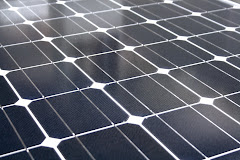 HONOLULU (AP) — Wind and solar power pioneers spent this week seeking their Holy Grail: the ability to easily sell renewable electricity for use on Hawaii's power grids.
HONOLULU (AP) — Wind and solar power pioneers spent this week seeking their Holy Grail: the ability to easily sell renewable electricity for use on Hawaii's power grids.Clean energy groups met with the state's major power company and regulators in an attempt to decide how much the utility would have to pay everyone from big clean energy developers to homeowners for their independently produced power. The five-day hearing at the Honolulu Country Club concluded Friday.
Setting a standard rate for renewable electricity is a key to Hawaii's transformation from the nation's most fossil-fuel dependent state to its most self-reliant.
"It really is the difference between us having a rapid development of large-scale renewable development in Hawaii, or having things stay the same," said Erik Kvam, chief executive officer for Zero Emissions.
This week's meetings provided the state Public Utilities Commission with information it will use to decide how to set prices for renewable energy and to make rulings on how much clean power can be accepted into each island's power grid.
If the regulators decide to enact the policy, called a feed-in tariff, Hawaii would become the first state in the nation to have these kinds of incentives for renewable energy.
"What is a fair price that will meet the needs of the developers but also protect the rate payers?" asked Peter Rosegg, a spokesman for Hawaiian Electric Co., which serves most of the state's power needs along with its subsidiaries, Maui Electric Co. and Hawaii Electric Light Co. "The question is in the details."
Hawaii depends on imported oil for about 90 percent of its energy, as it has for decades.Hawaiian Electric committed to work toward implementing feed-in tariffs when it signed on last year to Hawaii's Clean Energy Initiative, which aims to meet 40 percent of the state's energy needs through renewables by 2030.
The difficulty for the Public Utilities Commission will be finding a rate that encourages companies to invest in building renewable energy projects without forcing customers to pay much more for their power.
Following closing arguments Friday, the commissioners were left with more questions than answers, and they didn't appear close to making any ruling. A feed-in tariff will take months of additional debate and consideration before it's set.
"There's a lot of decisions that have to be made," said Carlito Caliboso, chairman of the commission. "There's a lot of balancing interests and policy we have to do."
Currently, companies that want to build expansive wind farms or solar projects have to go through a yearslong process with the state and Hawaiian Electric before they can get a contract to provide power to the grid.
With feed-in tariffs, companies would know how much they'd get paid for electricity from the start.
Some clean energy advocates worried that the commission wouldn't act fast enough or set a rate generous enough to attract "green" investment in Hawaii.
"If oil costs were still at $100 plus per barrel, our whole attitude at this hearing would be much different," said Jody Allione of Renewable Energy Consulting in her closing arguments.
The commissioners will have to think of ways to set fair rates for each island and ensure grid stability despite an influx of intermittent power, Rosegg said.
"The rate should make it attractive to developers, but much more importantly it should offer a long-term benefit to rate payers," said Doug Codiga, an attorney for Blue Planet Foundation, whose mission is to make Hawaii energy independent. "
There may be a short-term increase, it's possible, but over the long term the idea is that indigenous renewable energy is cheaper to rate payers than oil."







No comments:
Post a Comment